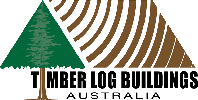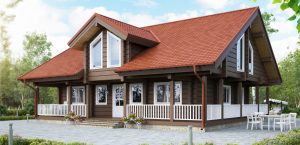Timber Log Info
All our residential solid timber log cabins are constructed using "GluLam" logs made from "Pinus Sylvestris" (more commonly known as "Baltic Pine" or "Scots Pine").

Scots Pine Plantation
There are huge pine plantations in the Baltic States (Estonia, Latvia and Lithuania), planted by Russia in the 70s and 80s before the Baltic States gained their independence in the mid 90s. Those days, Russia identified a future shortage of good quality timber building material, and consequently planted a huge number of Scots Pine saplings.
All of these are now becoming mature, guaranteeing a constant supply of excellent quality timber for the building industry and other general applications.
All timber used in the manufacturing of our cabins are sourced from these sustainable plantation timbers.
Baltic Pine
The white to pale yellow complexion of Baltic Pine stands out providing a unique point of difference among many homes. The Australian Timber Importers Federation notes that Baltic Pine is dissimilar from other European timbers when it comes to overall aesthetic. Growth rings aren’t all that prominent, while the wood is described as more “lustrous” than its regional counterparts. Baltic Pine does often feature small tight knots as the grain is usually straight and fine – perfect for not only floors, but also for log cabin walls.
If you’re looking for a timber that is traditional and well respected around the world, you’ll be hard-pressed to go past Baltic Pine. Dating back to the 1800s, the tree has been a mainstay of the world timber industry and apart from kiln drying improvements is still logged and produced the same way. Over close to 200 years, it’s proven time and time again how it can add value to properties across the globe.
Some of the main benefits of Baltic Pine are:

Typical Mature Plantation
Develops character over time - as a timeless timber, the golden colors of Baltic Pine continue to shine. In fact, the older the timber gets, the stronger and richer the character.
Responds to changing atmospheric conditions - in Australia, you need timber that can withstand our tough conditions throughout the year. A natural characteristic of Baltic Pine is that it moves and adjusts with the environment, ensuring it lasts longer. This also produces those surface and gapping variations which add further rustic character to the Baltic Pine character.
Works well with stains and polishes - over time, you may want to stain or polish your Baltic Pine surfaces to protect and maintain their rich colors. Due to the way that its manufactured, Baltic Pine works well with surface treatments such as varnishes, stains, oils and paints.
And a bit of "Wood Trivia":
Wood is the most environmentally sustainable building material.
Its competitors – concrete, brick, aluminium and steel – are energy-intensive and have a high reliance on fossil fuels while wood, in comparison, is abundant, renewable, stores carbon and has low inputs to process.
It has strength to weight ratio 20 per cent higher than steel and four to five times higher than non-reinforced concrete.
Far less carbon emissions are produced in the manufacture of timber products than other building materials. By building a house in timber the carbon emissions saved, compared to other materials, are equivalent to running a car for seven years.
Wood insulates 15 times better than concrete, 400 times better than steel and 1,770 times better than aluminium, and is more efficient at heating and cooling.










